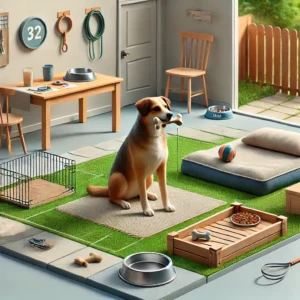Fundamentals of Routine in Dogs for Well-being and Stability
Benefits of Creating a Routine for Dogs: Below, I’ll guide you through the steps to establish a balanced and effective routine for your four-legged friend:
Step 1: Assessing Needs
Consider Age and Breed: The age, breed, and health status of your dog will influence their exercise, feeding, and rest needs. Puppies and young dogs, for example, typically require more physical activity and more frequent meals.
Observe Their Behaviour: Identify the times of day when your dog is most active, hungry, or tired. This will help you plan a routine that naturally fits their rhythm.
Step 2: Establishing Fixed Schedules – Creating a Routine for Dogs
Feeding: Decide on mealtimes and keep them consistent every day. Most dogs benefit from two meals a day.
Exercise: Schedule at least one or two daily exercise sessions, adjusting intensity and duration based on your dog’s needs.
Rest: Ensure your dog has time and a quiet space to rest between activities.
Step 3: Incorporating Mental Stimulation Activities into the Routine for Dogs
Obedience Training: Integrate short training sessions to keep their mind active and reinforce your bond.
Mental Games: Use interactive toys and scent games to keep your dog mentally stimulated.
There are many benefits to creating a routine for dogs. They are creatures of habit that feel safer and more comfortable when they know what to expect in their daily environment. A set routine provides them with a sense of security and predictability, which reduces anxiety and stress.
Knowing when they will receive their meals, when they will go for walks, and when it’s time to rest allows them to feel in control of their environment and more relaxed overall.
A routine that includes regular exercise, balanced feeding, and playtime is essential for a dog’s physical and mental health. One of the benefits of creating a routine for dogs and maintaining regular exercise is that it helps maintain a healthy weight and prevents health issues, while playtime and mental stimulation are important for keeping a dog’s mind active and engaged.
A well-established routine ensures these important aspects of canine health are consistently addressed.
Short, consistent training sessions using positive reinforcement can teach new tricks and commands, reinforcing their obedience and mental agility.
Puzzle toys and problem-solving games are excellent for keeping your dog’s mind active and preventing boredom.
Step 4: Establishing Personal Care Routines
Hygiene: Define a routine for grooming, dental care, and nail trimming. This may include regular brushing and scheduled baths.
Veterinary Visits: Plan regular veterinary check-ups and preventative maintenance, such as vaccinations and deworming.
Step 5: Adaptability and Adjustments
Be Flexible: Observe how your dog responds to the established routine and make adjustments as necessary. Flexibility is key to meeting their changing needs.
Introduce Variety: Change walking routes and introduce new games to avoid boredom.
Step 6: Consistency and Patience
Maintain Consistency: Once established, try to keep the routine as consistent as possible. Dogs thrive on predictability.
Be Patient: Every dog adapts at their own pace. Be patient and offer rewards and recognition to reinforce positive behaviour.
Step 7: Regular Evaluation
Review the Routine: Periodically evaluate your dog’s routine to ensure it’s still suitable for their well-being. As dogs age, their needs may change.
Step 8: Physical Exercise
Daily exercise is crucial for your dog’s physical and mental health. Depending on their breed, age, and energy level, the amount and type of exercise required may vary. Walks are essential, not only for exercise but also for providing mental stimulation through new smells and sights. Interactive games, such as fetch or tug-of-war, are also excellent for keeping your dog active and engaged. Incorporating variety in physical activities can help prevent boredom and keep your dog motivated and happy.
Step 9: Feeding and Hydration
Maintaining a regular feeding schedule is vital for your dog’s digestive health. Two meals a day, at consistent times, help regulate metabolism and prevent weight issues. The quality of food is equally important; choose foods that meet your dog’s specific nutritional needs based on their age, size, and activity level. Also, ensure your dog always has access to fresh, clean water, replacing it several times a day if necessary.
Step 10: Socialisation
Regular training not only improves your dog’s behaviour but also provides valuable mental stimulation. Socialisation is a critical component of a balanced routine, especially for puppies and young dogs. Exposing your dog to a variety of people, animals, and environments from an early age helps foster a balanced temperament and reduces the likelihood of fearful or aggressive behaviours. Visits to dog parks, walks in new environments, and meetings with friends and family are excellent ways to socialise your dog safely.
Step 11: Quality Time and Rest
Finally, spending quality time together is essential for strengthening your bond with your dog. Whether through cuddles on the sofa, interactive games, or simply being together in silence, these moments enhance the emotional connection between you and your dog. Equally important is ensuring your dog has a quiet, comfortable place to rest and sleep, allowing them to recharge after a day filled with activities.
Importance of Creating a Routine for Dogs

Routine is essential for the emotional and physical well-being of dogs. It provides structure, security, and predictability in their lives, helping them feel safe and calm in their environment. From mealtime to daily walks, establishing a consistent routine is crucial for promoting a balanced and happy lifestyle for your furry friend.
Reduction of Anxiety
Anxiety is common in dogs and can manifest in many ways, such as excessive barking, destructiveness, or hyperactive behaviour. An established routine can help reduce anxiety by providing dogs with a sense of normality and security in their daily lives. Knowing when to expect certain events, like the owner’s return home or walk time, can help calm nerves and promote tranquility.
Encouragement of Desirable Behaviours
A consistent routine also helps encourage desirable behaviours in dogs. When dogs know what is expected of them at different times of the day, such as sitting before receiving food or lying in their bed at night, they are more likely to follow these rules and behave appropriately. This can improve cohabitation and strengthen the bond between the dog and its owner.
Eases Adaptation to Changes
Finally, an established routine can ease a dog’s adaptation to changes in their life. Dogs are very sensitive beings and may become stressed when faced with sudden changes in their routine. However, if they have a solid routine in place, they are more likely to adapt to changes without experiencing significant stress or anxiety.
In summary, creating a consistent routine for your dog is essential for their physical and emotional well-being. It provides stability, security, and predictability in their daily lives, helping them feel calm, happy, and in control of their environment. By establishing a solid routine and following it consistently, you are investing in your furry friend’s long-term health and well-being.
Establishing a routine for your dog is fundamental to their physical and emotional well-being. A predictable routine not only helps manage your canine companion’s expectations but also strengthens the bond between you both, providing a structure that promotes security and happiness.
Characteristics of a Healthy Dog: Signs of Canine Well-being

Observing the characteristics of a healthy dog is essential for maintaining their overall well-being. From a balanced diet to regular physical activity and proper veterinary care, taking care of your dog in all aspects contributes to a happy and healthy life together.
Relaxed Body Language
A happy dog typically has a relaxed body, with its tail high (depending on the breed) and wagging in a relaxed or energetic manner. Their ears will be in a natural position, neither pulled back in submission nor forward in alertness. Additionally, a content dog often has a “smile,” with its mouth slightly open and the tongue possibly hanging out casually.
Interest in the Surroundings
A dog that shows curiosity about its surroundings, investigates new smells, and shows enthusiasm when exploring during walks is generally a happy dog. This curiosity reflects a positive mood and a high level of emotional well-being.
Peaceful Sleep
A happy dog will enjoy regular, peaceful sleep patterns. Sleeping well is essential for physical and emotional health, and a dog that can rest deeply, without signs of restlessness or anxiety, is generally well-adjusted and content in its environment.
Positive Response to Training
A willingness to learn and respond enthusiastically to training, without showing signs of fear or anxiety, indicates that a dog feels motivated and happy. Positive reinforcement and successful learning experiences boost their confidence and satisfaction.
Relaxed Behaviour at Home
At home, a happy dog often lies with its stomach exposed, a position that denotes trust and comfort. They will seek out their owners’ company spontaneously but are also content enjoying moments of peace on their own.
Finally, Routine in Dogs is Crucial for Their Physical and Emotional Well-being
Just like humans, dogs find security and comfort in the predictability of daily life. A well-established routine in dogs not only helps them better adapt to their environment but also reduces stress and anxiety, particularly in situations of change or uncertainty, such as the loss of a pet or human companion. Maintaining regular schedules for feeding, walks, and play provides dogs with a sense of structure that helps them feel more relaxed and secure.
One of the most important benefits of a routine in dogs is that it helps regulate their physical needs. When dogs know when they will eat or go for a walk, their bodies adjust to those schedules, improving digestion and elimination habits. Additionally, the predictability of a routine can make training easier, as dogs learn faster when activities are consistently repeated.
Another benefit is the positive impact a routine has on their behaviour. Dogs without a clear structure can develop behavioural problems, such as excessive barking, destruction of objects, or aggression. An established routine helps channel their energy appropriately and prevents them from feeling frustrated or confused.
Routine is also crucial for their mental health. During times of change or mourning, a daily structure can offer a sense of normality and help them adapt better to difficult situations. In summary, a routine is essential for a dog’s emotional and physical balance, contributing to their overall well-being.
Creating a routine for dogs requires commitment and flexibility, but the benefits for their health and happiness are immeasurable. By addressing your dog’s physical, emotional, and mental needs through a well-thought-out daily structure, you are laying the foundation for a long, healthy, and happy life together.
For more information visit our blog
